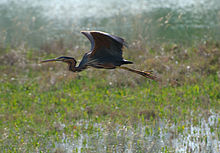 |
| Great Bittern |
 |
| Grey Heron |
The first matter to remember is that many of these new colonists are actually recolonisation, with several species now known to have been regularly sold for the table at London markets from the medieval period through to the 16th century, and most were locally caught and therefore almost certainly breeders rather than vagrants It was probably a combination of hunting pressure, drainage of wetlands, and the chilly climate of the Little Ice Age that caused their (temporary) extinction in Britain. For example, in the 16th century markets various species fetched the following prices (in old pennies):
‘Brewe’/Night Heron: 12-16d
Little/?Great Egret: 12-16d
White Stork: 24-48d
‘Shoveller’/ Spoonbill: 8-24d
Great Bittern: 8-32d
While many of these prices would have been very steep for an ordinary Londoner, they are comparable to the costs of ducks, waders, and other game that was taken for food and sold at the same markets. In addition, a Sir Thomas Browne, writing in the 17th century, mentions a ‘black heron’ (probably Purple Heron). Some other birds, such as Little Bittern, were probably too secretive to notice, but are likely to have also been breeding birds in that period.
The reason these records have been overlooked is probably because they had ceased to be breeders by the time ornithology in Britain got seriously underway in the 19th century, and it was assumed that any references or even paintings were based on continental imports or copies of European works. These records are now in need of review, especially since so many of them have recently begun appearing in Britain in increasing numbers, and so many are starting to breed. The current state of play looks like this:
Little Egret Egretta garzetta
 |
| Little Egret |
Cattle Egret Bubulcus ibis
 |
| Cattle Egret |
Great White Egret Ardea alba
 |
| Great White Egret |
Purple Heron Ardea purpurea
 |
| Purple Heron |
Little Bittern Ixobrychus minutus
 |
| Little Bittern |
These tiny reedbed herons are so secretive that confirming breeding is very difficult. However, at least one recently fledged juvenile was seen at a site in Somerset in 2010
 |
| Eurasian Spoonbill |
After many years of unsuccessful and half-hearted breeding attempts by juveniles, and fair number of non-breeders spending the summer away from the nearest colonies in the Netherlands, spoonbill colonisation took off in a big way in 2010 with an instant colony of six pairs in Norfolk, raising 10 young between them. In 2011 8 pairs raised 14 young, and the same number of pairs have returned this year. Some summering and breeding attempts have also been made at other locations, but the Norfolk colony is currently the centre of the population.
White Stork Ciconia ciconia
| European White Stork |
Most often seen on migration in the UK, there was an unsuccessful nesting attempt in 2004 and this year there have been several records of birds carrying out nest-building. As there is such a close association with human constructions, any nesting attempt will be visible to all.
Night Heron Nycticorax nycticorax.
 |
| Black-crowned Night Heron |
Although it seems to have been fairly widespread in the Middle Ages, as yet the only Night Herons to be found in the UK are occasional overshoots from the continent on spring migration (I saw one at Slimbridge a few years ago). The European population is increasing, and they breed as close as the Netherlands, so it would not be at all surprising if they one more began to breed in the UK as well.
Glossy Ibis Plegadis falcinellus
 |
| Glossy Ibis |
A pretty improbable bird one would think to colonise the UK, but in 2007 in an astonishing development a flock of no less than 17 birds showed up at Slimbridge. Although no breeding attempts have been made (or at least reported) they have been fairly regular in the UK since then and many people expect them to make a nesting attempt at some point in the near future.
The reasons for this sudden invasion of herons is probably a combination of factors. Increased protection has probably helped a general increase in population, with consequently more potential founders for new colonies. I wonder also whether the spread of the introduced Marsh Frog (now widespread on the Somerset Levels) may have something to do with it, as frogs are a large part of the diet of many heron species. In the main though, I suspect that a warming climate is making it easier for birds to overwinter further north, and so be in a good location for breeding attempts in the spring.
References:
Fred Stubbs, Egrets, Brewes and Climate Change. W.R.P. Bourne British Birds 96 July 2003
No comments:
Post a Comment